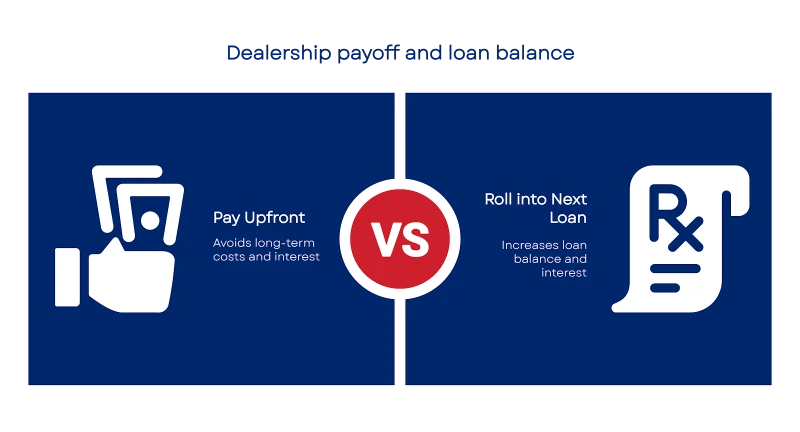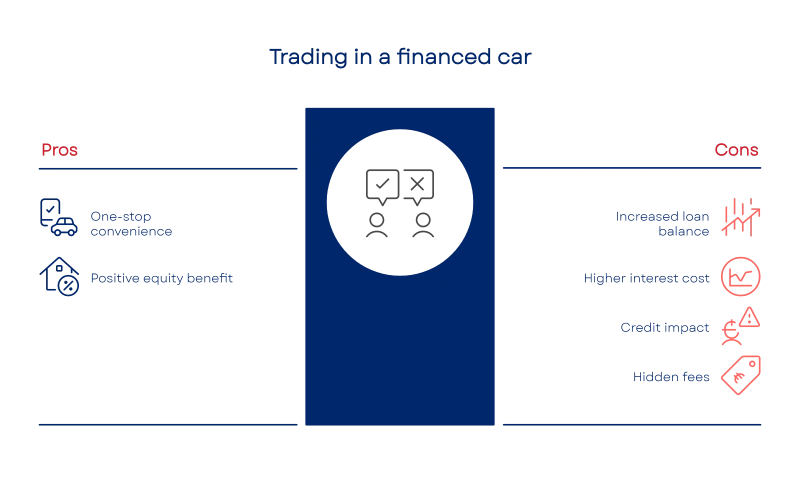You can still trade it in. However, doing so without knowing your numbers can lead to a higher loan balance and increased long-term costs, especially when looking for affordable used cars.
If the dealership payoff is lower than what you owe, the difference becomes your responsibility. That amount can either be paid upfront or rolled into your next loan. This affects both your monthly payment and your total interest paid. Knowing how this works helps you avoid expensive terms and protects your credit from dealer delays.
What You’ll Learn
This guide covers three key questions:
Can you trade in a car that still has a loan on it?
What happens to the unpaid balance on your current loan?
What can you do if your vehicle is worth less than what you owe?
You’ll learn how to read trade-in offers, confirm your loan payoff, and avoid rolling debt into a new loan without knowing the full impact.
Summary
Yes. A dealership can accept a vehicle that still carries a loan, refinance that loan with your lender, and apply any surplus (or deficit) to the next purchase. The transaction involves two steps: paying off the existing loan and arranging a new one, so knowing the numbers in advance is essential.
How the Math Works
Get a 10-day payoff quote from your lender (the exact amount required to close the loan).
Ask several dealers for written trade-in offers.
Compare the offer to the payoff:
If the offer exceeds the payoff, you have positive equity, and the surplus becomes part of your down payment.
If the offer is lower, you have negative equity; you must either pay the shortfall in cash or roll it into the new loan (which raises both the balance and the payment).
Checklist
Know Your Numbers: Get a payoff quote and real-world trade value from at least two sources, such as a KBB Instant Cash Offer and a competing dealer.
Separate Negotiations: Treat the trade value, new-car price, and financing terms as three independent deals.
Demand Written Proof: The buyer's order should list the full trade allowance and the exact payoff amount; keep a copy.
Monitor the Payoff: Continue making payments until your lender shows a zero balance; late payoffs hurt your credit.
Watch for Fees: Rolling negative equity into a new loan means paying interest on yesterday’s debt; consider paying the deficit upfront instead.
Pros and Cons
Trading in a financed car is simple once you know your payoff and the vehicle’s actual market value. Protect yourself by separating each part of the deal, insisting on written documentation, and monitoring your old loan until it is officially closed.
Know Your Payoff and Trade Value
You need two figures before trading in a financed car:
Your loan payoff amount
Your car’s actual trade-in value
These numbers determine your equity position.
If the car’s value is higher than the payoff, you have positive equity. That amount can be applied to your next loan or used as a down payment. If the payoff is higher than the car’s value, you have negative equity and must either cover the difference in cash or roll it into the next loan.
You can get your payoff amount by requesting a 10-day payoff quote from your lender. For trade value, use sources like Kelley Blue Book or Edmunds, and ask multiple dealers for written offers.
Most dealers refer to published pricing tools when assessing trade-in offers, using sources that reflect current vehicle market values across trim levels and mileage bands.
Skipping this step puts you at a disadvantage. Always confirm both numbers before agreeing to a trade.
Why This Trade-In Process Matters
Many people trade in vehicles while still paying off a loan. In 2024, 44 percent of trade-ins had outstanding balances. About 25% of those had negative equity.
When negative equity is rolled into a new loan, monthly payments typically increase by $72 to $128 per month. If the dealership delays paying off the existing loan, it can result in a 30-day late mark on your credit report. Such late payments can reduce a credit score by 30 to 100 points.
Understanding how these trade-ins work helps you avoid added costs, higher interest, and credit damage caused by late loan closure.
Equity Basics
Understanding equity helps you see how your loan balance compares to the value of your car. The table below explains key terms and how they affect your trade-in:
Knowing your equity position before trading helps prevent surprises and enables you to negotiate more confidently.
How the Trade-In Process Works
Trading in a financed car involves two transactions: the dealer pays off your existing loan and applies your car’s trade-in value to the next deal. Each step matters. Here’s how to manage the process with clarity and control.
Step-by-step checklist:
Request a 10-day payoff quote from your lender
This quote shows the exact amount needed to pay off your loan. Ensure the quote includes interest for the next 10 calendar days, not business days. Lenders calculate interest daily, so the payoff amount changes over time.
Estimate your vehicle’s current trade-in value.
Utilize pricing tools such as Kelley Blue Book and Edmunds. Choose the condition that accurately reflects your vehicle. Be honest about mileage, maintenance history, and cosmetic condition. Print or save a copy of the valuation as a reference during negotiations.
Compare the payoff to the trade-in value
Subtract the loan payoff from the estimated value:
If the value is higher, you have positive equity.
If the payoff is higher, you have negative equity.
Get multiple written trade-in offers.
Don’t rely on just one offer. Visit or contact at least two dealerships and request itemized written offers. The more accurate the competition, the better your leverage.
Request a complete buyer’s order.
This document outlines all costs and credits. Check that it lists:
Full trade-in allowance
Exact loan payoff amount
Down payment (if applicable)
New vehicle price
Taxes, fees, and the total financed amount
Keep trade-in, financing, and vehicle pricing as separate discussions
Dealers may combine these into a single offer, but it’s important to treat them as three separate transactions:
First: Agree on the trade-in value
Second: Finalize the price of the new car
Third: Review financing terms
Continue making loan payments until the lender shows a zero balance
Some dealers take time to send the payoff. A delay of more than 30 days can result in late payment reporting, which can negatively impact your credit score. Confirm with your lender when the account is fully closed.
Trade-in values vary by location and condition, and some sellers receive more by exploring competitive markets where car resale value tends to be highest.
Avoid common traps:
“We’ll pay off your loan no matter what.”
This typically means rolling the negative equity into your next loan without clearly showing how it affects the payment. Ask to see how the numbers are applied line by line.
“Spot delivery” before financing is complete.
Don’t take the new car home until the financing is finalized and documented. If financing falls through, you may be asked to return the vehicle or accept less favorable terms.
Staying thorough at every stage protects your finances, your credit, and your leverage when negotiating.
How Trade-Ins Affect Your Credit
A trade-in with a remaining loan can affect your credit depending on how the process is handled. The key factor is whether your old loan is paid off promptly and how much new debt you take on.
Here’s how everyday actions during a trade-in impact your credit score:
Late loan payoff is the most serious issue. It occurs when the dealership fails to send the payment to your lender on time, despite your assumption that the loan was handled. Keep making your regular payments until your lender confirms the loan is closed and the balance is zero.
Adding negative equity to your next loan can also negatively impact your credit. A higher balance increases your total debt, which can lower your score, especially if your loan balance is close to the vehicle’s value.
To protect your credit:
Confirm the old loan is paid in full
Get documentation from both the dealer and the lender
Monitor your credit report after the trade
If you see a late mark that’s due to a dealer delay, dispute it with your lender and provide proof of the trade-in date.
Negotiation Scripts
When you know your equity position, you can control the conversation. Use these scripts to explain what you want and how your trade should be handled.
Positive Equity
“My trade-in is worth $19,000, and my loan payoff is $14,500. Please apply the full $19,000 as the trade allowance. After the payoff, credit the $4,500 difference toward my down payment.”
This keeps the trade value intact and applies your equity to reduce the amount you’ll finance.
Negative Equity
“My trade-in value is $12,000, and I owe $14,800. I’ll pay the $2,800 difference today. Please list that as a down payment, not part of the loan balance.”
This avoids rolling old debt into your new loan, which raises your balance and increases long-term interest costs.
Some trade-ins involve negative equity, where the loan amount exceeds the car’s current value, commonly referred to as being upside down on an auto loan.
Always ask the dealer to confirm these details in the buyer’s order before signing any paperwork. Ensure that the full payoff amount and the method of equity application are clearly stated.
Final Thoughts
You can trade in a car with a loan on it, but the results depend on the details. Start by knowing your loan payoff and your car’s current market value. That shows whether you have equity to work with or a balance to resolve.
Compare multiple trade-in offers. Keep the trade value, new car pricing, and financing terms separate. Request everything in writing and review each item carefully before agreeing to the deal.
Keep making loan payments until your lender confirms the balance is paid in full. That protects your credit and helps you avoid late fees.
With the correct information, you can make a clean, informed trade without carrying over unnecessary debt.
Need Help Shipping Your Car?
If you’re trading in or selling your vehicle across state lines, AmeriFreight Car Shipping is here to help.
We work with licensed and insured carriers that offer both open and enclosed auto transport options. Whether your vehicle is heading to a dealership or a private buyer, we can help coordinate pickup and delivery.
Get a shipping estimate based on your location, schedule, and vehicle type. We are available to answer questions and explain the process in detail.
Transport rates vary based on route, vehicle size, and shipping type, which you can explore using our auto transport cost calculator.
Frequently Asked Questions (FAQs)
Is it possible to trade in a financed car with high mileage?
Yes. High mileage lowers the value, but you can still trade it in.
Can I trade in a financed car if I'm looking to downgrade to a cheaper vehicle?
Yes. The loan balance and trade value decide if you’ll carry over any difference.
Buyers focused on long-term reliability often opt for new vehicles, which typically require fewer early repairs.
Should I get multiple trade-in offers from different dealerships for my financed car?
Yes. Offers vary. Getting more than one helps you get better value.
Do dealerships offer different trade-in values for financed cars compared to paid-off cars?
No. Value depends on the car, not the loan. Financing affects how value is applied.
Do used cars hold value better over time?
Used vehicles may depreciate at a slower rate, making them appealing to trade-in buyers concerned about retained value.
Disclaimer: This article is for informational purposes only and should not be considered financial or legal advice. Always review your loan terms and consult a qualified professional before making decisions regarding trade-ins or financing.






















